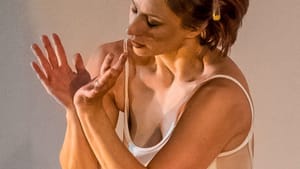Stay in the Loop
BSR publishes on a weekly schedule, with an email newsletter every Wednesday and Thursday morning. There’s no paywall, and subscribing is always free.
At home in her body
JCWK Dance Lab presents ‘HOMEbody’

What does home mean to you? Is it a place, a feeling, a community? These are questions JCWK Dance Lab explores in HOMEbody, its new full-length work. Run by Jessica C. Warchal-King, who also curates the Kun-Yang Lin/Dancers InHale performance series, JCWK Dance Lab uses dance to tell stories and create positive social change. HOMEbody left unanswered most of the interesting and ambitious questions it raised, despite visually appealing and whole-hearted dancing.
Teary testimony
Some of the most powerful moments of the performance came before the dancing began. As people entered and took their seats, they heard a musical playlist of songs about the idea of home. Next, Warchal-King took the stage and addressed the full house, leading viewers through a guided visualization. She asked the audience to close their eyes and imagine sitting in our most comfortable chair in a favorite place. Next, Warchal-King invited us to explore the sounds and sensations, physical and emotional, that arose as we envisioned resting in our comfortable, welcoming place. The tears that came to my eyes provided testimony to the power of home and belonging.
Shed
Next, Warchal-King performed a solo she choreographed. Set to instrumental music by Jude Eden, Shed drew from the strengths of Warchal-King’s choreography and dancing. These included creative use of tempo and space as Warchal-King moved across the stage in varying speeds and styles, as well as her frequent use of balances and evocative hand gestures. Some movement was jerky and some sinuous, and Warchal-King shifted between them with admirable skill.
Shed was strongest when engaging with images and themes related to the concept of home. For instance, a single prop—a square table with folding legs—became a hiding place, a stage, and an altar. A sequence in which Warchal-King’s feet slowly pedaled the air suggested the rote and repetitive tasks of keeping house, and the domestic activities most of us perform each day automatically and without thinking, from opening curtains to setting a table. As a whole, though, Shed was too abstract to send a clear message.
Not everyone is at home
It was followed by Jake Buczweski’s mini-documentary, which more clearly conveyed ideas and emotions as it provided a behind-the-scenes look at the making of HOMEbody. Between shots of the dancers rehearsing, they spoke about their perceptions of and feelings about home. Warchal-King explained how the different experiences of the five performers shaped the dance. Sarena Kabakoff’s observations about the body as a home were a highlight that felt particularly relevant in the aftermath of #MeToo, as more people and organizations become increasingly aware of and informed about trauma. Unfortunately, far too many people still do not feel safe and at home in their bodies.

Too impressionistic?
The dance fell short of sufficiently addressing these topics in accessible ways. HOMEbody, like Warchal-King’s solo Shed, was thoughtfully conceived and skillfully performed but perhaps too impressionistic. I found myself wishing for a narrative, or even more concrete symbols of home and belonging. However, Laura Baehr, Erin Coffey, Kyleigh Kover, Kabakoff, and Warchal-King helped make HOMEbody lovely to watch.
Repetition of images and movement phrases raised questions about safety, belonging, struggle, and survival. Kabakoff balanced on one shoulder, lifting her legs into the air to form sculptural shapes. Warchal-King entered the space to watch, motionless, as the first of a series of guardian-like sentinels. Changes in Paul Fejko’s original music signaled changes in movement.
A recurring configuration involved Baehr, Kabakoff, and Warchal-King forming a trio which took turns lifting and supporting one another’s bodies and catching them as they seemed to fall. There was intimacy in the gesture of one dancer leaning her head on another’s thigh, as well as a sequence in which Kabakoff crawled on all fours with Baehr draped across her back. I saw the inter-relational nature of home in these parts, and I would have welcomed more exploration of this theme.
Syncopated breath
Percussive breath contributed to another memorable feature of HOMEbody. Dancers synchronized their movements to syncopated breathing. Expressive hand gestures combined with dancers repeatedly counting one, two, three, four as their hands covered their throats, bellies, mouths, and eyes. Fascinated, I wondered what this said about finding home in a place, a feeling, a body, or a community.
An innovative concept, HOMEbody offered interesting ideas and beautiful images, but it did not quite cohere as an exploration of home.
What, When, Where
HOMEbody. Choreography by Jessica C. Warchal-King. JCWK Dance Lab. February 22, 2020 at Kun-Yang-Lin/Dancers’s CHI Movement Arts Center, 1316 S. 9th Street, Philadelphia. jcwarchalking.blogspot.com/p/the-embodiment-project.
Sign up for our newsletter
All of the week's new articles, all in one place. Sign up for the free weekly BSR newsletters, and don't miss a conversation.

 Melissa Strong
Melissa Strong